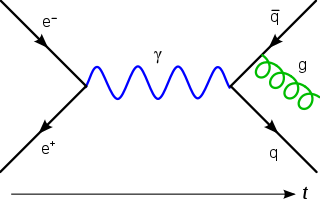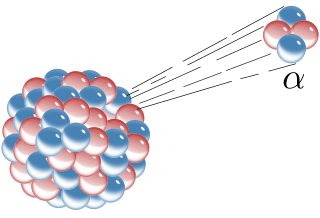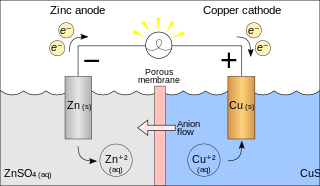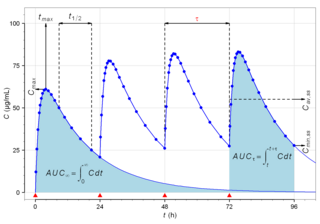In architecture, a respond is a half-pier or half-pillar that is bonded into a wall and designed to carry the springer at one end of an arch. [1]
In architecture, a respond is a half-pier or half-pillar that is bonded into a wall and designed to carry the springer at one end of an arch. [1]

In nuclear physics, beta decay (β-decay) is a type of radioactive decay in which an atomic nucleus emits a beta particle, transforming into an isobar of that nuclide. For example, beta decay of a neutron transforms it into a proton by the emission of an electron accompanied by an antineutrino; or, conversely a proton is converted into a neutron by the emission of a positron with a neutrino in what is called positron emission. Neither the beta particle nor its associated (anti-)neutrino exist within the nucleus prior to beta decay, but are created in the decay process. By this process, unstable atoms obtain a more stable ratio of protons to neutrons. The probability of a nuclide decaying due to beta and other forms of decay is determined by its nuclear binding energy. The binding energies of all existing nuclides form what is called the nuclear band or valley of stability. For either electron or positron emission to be energetically possible, the energy release or Q value must be positive.

In theoretical physics, a Feynman diagram is a pictorial representation of the mathematical expressions describing the behavior and interaction of subatomic particles. The scheme is named after American physicist Richard Feynman, who introduced the diagrams in 1948. The interaction of subatomic particles can be complex and difficult to understand; Feynman diagrams give a simple visualization of what would otherwise be an arcane and abstract formula. According to David Kaiser, "Since the middle of the 20th century, theoretical physicists have increasingly turned to this tool to help them undertake critical calculations. Feynman diagrams have revolutionized nearly every aspect of theoretical physics." While the diagrams are applied primarily to quantum field theory, they can also be used in other areas of physics, such as solid-state theory. Frank Wilczek wrote that the calculations that won him the 2004 Nobel Prize in Physics "would have been literally unthinkable without Feynman diagrams, as would [Wilczek's] calculations that established a route to production and observation of the Higgs particle."

Half-life is the time required for a quantity to reduce to half of its initial value. The term is commonly used in nuclear physics to describe how quickly unstable atoms undergo radioactive decay or how long stable atoms survive. The term is also used more generally to characterize any type of exponential decay. For example, the medical sciences refer to the biological half-life of drugs and other chemicals in the human body. The converse of half-life is doubling time.

Radioactive decay is the process by which an unstable atomic nucleus loses energy by radiation. A material containing unstable nuclei is considered radioactive. Three of the most common types of decay are alpha, beta, and gamma decay. The weak force is the mechanism that is responsible for beta decay, while the other two are governed by the electromagnetic and nuclear forces.

A galvanic cell or voltaic cell, named after the scientists Luigi Galvani and Alessandro Volta, respectively, is an electrochemical cell in which an electric current is generated from spontaneous oxidation–reduction reactions. An example of a galvanic cell consists of two different metals, each immersed in separate beakers containing their respective metal ions in solution that are connected by a salt bridge or separated by a porous membrane.

A quantity is subject to exponential decay if it decreases at a rate proportional to its current value. Symbolically, this process can be expressed by the following differential equation, where N is the quantity and λ (lambda) is a positive rate called the exponential decay constant, disintegration constant, rate constant, or transformation constant:

The Mississippi River Alluvial Plain is an alluvial plain created by the Mississippi River on which lie parts of seven U.S. states, from southern Louisiana to southern Illinois.
In sports, a winning percentage or Copeland score is the fraction of games or matches a team or individual has won. The statistic is commonly used in standings or rankings to compare teams or individuals. It is defined as wins divided by the total number of matches played. A draw counts as a 1⁄2 win.
Thorium (90Th) has seven naturally occurring isotopes but none are stable. One isotope, 232Th, is relatively stable, with a half-life of 1.405×1010 years, considerably longer than the age of the Earth, and even slightly longer than the generally accepted age of the universe. This isotope makes up nearly all natural thorium, so thorium was considered to be mononuclidic. However, in 2013, IUPAC reclassified thorium as binuclidic, due to large amounts of 230Th in deep seawater. Thorium has a characteristic terrestrial isotopic composition and thus a standard atomic weight can be given.
Natural tantalum (73Ta) consists of two stable isotopes: 181Ta (99.988%) and 180m
Ta
(0.012%).
Naturally occurring neodymium (60Nd) is composed of five stable isotopes, 142Nd, 143Nd, 145Nd, 146Nd and 148Nd, with 142Nd being the most abundant (27.2% natural abundance), and two long-lived radioisotopes, 144Nd and 150Nd. In all, 35 radioisotopes of neodymium have been characterized up to now, with the most stable being naturally occurring isotopes 144Nd (alpha decay, a half-life (t1/2) of 2.29×1015 years) and 150Nd (double beta decay, t1/2 of 9.3×1018 years), and for practical purposes they can be considered to be stable as well. All of the remaining radioactive isotopes have half-lives that are less than 11 days, and the majority of these have half-lives that are less than 70 seconds; the most stable artificial isotope is 147Nd with a half-life of 10.98 days. This element also has 15 known meta states with the most stable being 139mNd (t1/2 5.5 hours), 135mNd (t1/2 5.5 minutes) and 133m1Nd (t1/2 ~70 seconds).
Selenium (34Se) has six natural isotopes that occur in significant quantities, along with the trace isotope 79Se, which occurs in minute quantities in uranium ores. Five of these isotopes are stable: 74Se, 76Se, 77Se, 78Se, and 80Se. The last three also occur as fission products, along with 79Se, which has a half-life of 327,000 years, and 82Se, which has a very long half-life (~1020 years, decaying via double beta decay to 82Kr) and for practical purposes can be considered to be stable. There are 23 other unstable isotopes that have been characterized, the longest-lived being 79Se with a half-life 327,000 years, 75Se with a half-life of 120 days, and 72Se with a half-life of 8.40 days. Of the other isotopes, 73Se has the longest half-life, 7.15 hours; most others have half-lives not exceeding 38 seconds.
Germanium (32Ge) has five naturally occurring isotopes, 70Ge, 72Ge, 73Ge, 74Ge, and 76Ge. Of these, 76Ge is very slightly radioactive, decaying by double beta decay with a half-life of 1.78 × 1021 years (130 billion times the age of the universe).
Naturally occurring zinc (30Zn) is composed of the 5 stable isotopes 64Zn, 66Zn, 67Zn, 68Zn, and 70Zn with 64Zn being the most abundant. Twenty-eight radioisotopes have been characterised with the most stable being 65Zn with a half-life of 244.26 days, and then 72Zn with a half-life of 46.5 hours. All of the remaining radioactive isotopes have half-lives that are less than 14 hours and the majority of these have half-lives that are less than 1 second. This element also has 10 meta states.

Biological half-life is the time taken for concentration of a biological substance to decrease from its maximum concentration (Cmax) to half of Cmax in the blood plasma. It is denoted by the abbreviation .
The 1892 Boston Beaneaters season was the 22nd season of the franchise. The Beaneaters won their second straight and fifth overall National League pennant. In the league's first split season, the Beaneaters finished first in the first half, and three games behind the Cleveland Spiders in the second half. After the season, the two teams played a "World's Championship Series", which the Beaneaters won, five games to none. The National League did not play another split season until 1981.

In geometry, the major axis of an ellipse is its longest diameter: a line segment that runs through the center and both foci, with ends at the two most widely separated points of the perimeter. The semi-major axis is the longest semidiameter or one half of the major axis, and thus runs from the centre, through a focus, and to the perimeter. The semi-minor axis of an ellipse or hyperbola is a line segment that is at right angles with the semi-major axis and has one end at the center of the conic section. For the special case of a circle, the lengths of the semi-axes are both equal to the radius of the circle.
SS Thesis was a steamship which was wrecked in October 1889 in the Sound of Mull, on Scotland's west coast. She is now a popular dive site with scuba divers.

Keihin is a Japanese automotive and motorcycle parts brand of Hitachi Astemo. At the past times, Keihin was a major supplier to Honda, who owned nearly half of Keihin's shares, but also supplies other motorcycle manufacturers, among them Triumph, Suzuki, Kawasaki, KTM, Royal Enfield and Harley-Davidson. In addition to carburetors, Keihin supplies the automotive industry with engine, transmission, and climate control products, including intake manifold assemblies, HVAC assemblies, compressors, valves, solenoids, and engine control units.

The Palm Tree is a Grade II listed public house at 127 Grove Road, Mile End, and is within Mile End Park.